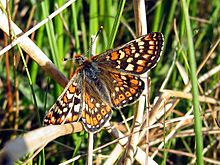Strawberry Banks facts for kids
| Site of Special Scientific Interest | |

Example - marsh fritillary (Euphydryas aurinia)
|
|
| Area of Search | Gloucestershire |
|---|---|
| Coordinates | 51°43′42″N 2°07′54″W / 51.7283°N 2.1318°W |
| Interest | Biological |
| Area | 5.1 hectare |
| Notification | 1993 |
Strawberry Banks is a special nature area in Gloucestershire, England. It covers about 5 hectares (12.5 acres). This area was officially recognized in 1993 because of its important wildlife.
It is managed by the Gloucestershire Wildlife Trust as a nature reserve. People think the name "Strawberry Banks" comes from a time when strawberries were grown here. The reserve is next to another nature area called Three Groves Wood. It sits on the western side of a small valley in the Cotswolds. You can find it between the villages of France Lynch and Oakridge. Strawberry Banks is about 5 kilometers (3 miles) east of Stroud. It is part of a group of nature reserves in an area known as Stroud's Golden Valley.
This site is very important for wildlife. It has a large number of marsh fritillary butterflies. It is also one of the few places in Britain where a rare oil beetle called Meloe rugosus lives.
Contents
Amazing Plants at Strawberry Banks
Strawberry Banks has a special type of grassland. It grows on "oolitic limestone," which is a kind of rock made from tiny round grains. This soil helps many different plants and animals to thrive.
In spring (May and June), you can see many beautiful flowers. These include the greater butterfly-orchid, bee orchid, and common spotted orchid. Other plants like wild columbine, common rock-rose, and milkwort also bloom. Look for kidney vetch, wild thyme, yellow rattle, and devil's bit scabious.
Earlier in the year, you might spot Green-winged orchids, cowslips, and early purple orchids. Wood anemones, hairy violets, and bluebells also appear.
Later in summer, more flowers bloom. These include the pyramidal orchid and autumn gentian. You can also find clustered bellflowers, Carline thistles, and betony. Yellow-wort, marjoram, zigzag clover, small scabious, and Dyer's greenweed add to the colorful display.
You might also see sainfoin here. This plant was grown many years ago as food for farm animals in the Cotswolds.
Trees and Shrubs
Parts of Strawberry Banks have areas with trees and shrubs. These include hawthorn, hazel, ash, pedunculate oak, holly, and blackthorn. In these areas, you might find plants like Toothwort, nettle-leaved bellflower, woodruff, and sanicle.
A small stream flows at the bottom of the banks. Trees and shrubs line its edges. Here, you can find plants like meadowsweet, ramsons (also known as wild garlic), brooklime, and water figwort.
Incredible Insects and Snails
Strawberry Banks is famous for its many different insects. The most well-known is the marsh fritillary butterfly.
Other butterflies you might see include the small blue, green hairstreak, and chalkhill blue. Look out for the Duke of Burgundy, marbled white, and silver-washed fritillary. The grizzled skipper, comma, and brown argus butterflies also live here.
Besides butterflies, the reserve is home to Roman snails and heath snails. A very rare oil beetle called Meloe rugosus also lives here.
Protecting Strawberry Banks
People work hard to keep Strawberry Banks healthy. Since 1969, horses and ponies have gently grazed the banks. This helps to keep the grassland in good condition.
Workers also regularly cut back unwanted bushes and trees. Some large beech trees at the edge of Three Groves Wood have been cut down. This helps to make the grassland bigger and better for the many different plant species that live there.
Exploring the Golden Valley
There is a special guide that describes walks in the Golden Valley. These walks are great for enjoying nature and seeing wildlife. The guide includes information about Strawberry Banks and four other nearby nature reserves. These are Three Groves Wood, Siccaridge Wood, Daneway Banks SSSI, and Sapperton Valley.
The walks also take you through other old woodlands like Peyton's Grove. You can explore Oakridge village, Bakers Mill and Reservoir, and Ashmeads Spring. Part of the route follows the old Thames and Severn Canal.

